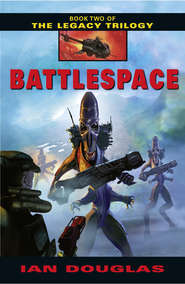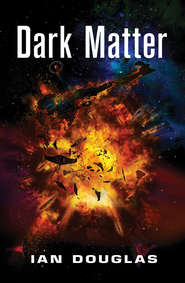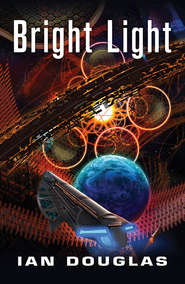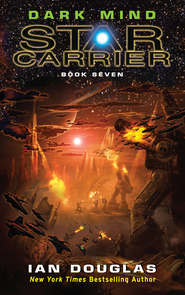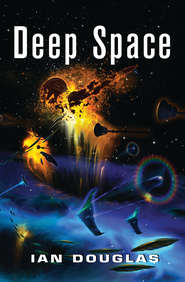По всем вопросам обращайтесь на: info@litportal.ru
(©) 2003-2024.
✖
Singularity
Настройки чтения
Размер шрифта
Высота строк
Поля
1715 hours, TFT
“Things are about to go supercritical,” Gray said over the squadron tac channel. “Reconfigure to sperm mode.”
The SG-92 Starhawk’s outer hull consisted of a matrix of conventional metals and ceramics blended with nano-molecules controlled by an electrical field projected by his ship’s AI. Launch configuration was a slender needle with a swollen central area housing the cockpit, designed for magnetic acceleration down the launch tube. Combat configuration looked a bit like a headless bird with down-canted wings, providing widely separated weapons and sensor platforms useful in a fight.
Sperm mode was fighter-slang for high-velocity configuration—a blunt-nosed egg shape with a long, tapering tail. The old, conventional wisdom that said that spacecraft didn’t need to be streamlined in the vacuum of space broke down when the vessel could approach the speed of light. At those speeds every little bit helped.
Gray didn’t know what was going to happen in the next few moments, but he did know that their survival would depend upon their speed and their maneuverability.
The twelve Starhawks had been patrolling in combat mode, but now their wings began folding in toward their bodies, their black surfaces turning cold-molten and flowing like thick water. They were drifting along the no-cross line, an empty region of space defined by its distance, 100,000 kilometers, from the America.
The heavy cruiser Valley Forge was only five kilometers off his starboard side at the moment, three quarters of a kilometer long, a slender stem behind an outsized forward cap shaped like a flattened dome. To the naked eye, she appeared slightly blurred and indistinct. Shield technology involved bending space sharply above and around a ship’s hull, and that bending caused light to twist. When an incoming projectile or thermonuclear detonation struck the field projected across a warship’s outer hull, that spatial warping momentarily became much stronger, deflecting the threat. Gravitic shielding was costly in terms of energy, however, and was generally switched on only when combat was imminent. Koenig, clearly, was taking no chances; high-velocity kinetic rounds could come slamming out of the darkness with little to no warning at all, and all ships in the battlegroup were at the highest possible alert status.
According to the tactical display, Jeanne d’Arc and the eleven other capital ships of the Pan-European contingent were a scant half million kilometers away, drawing ever closer.
“Hey … Skipper?” It was Shay Ryan, on a private channel.
“Yeah?”
“I don’t like the idea of shooting at our own guys, y’know?”
“Neither do I, Lieutenant.”
“If we get shot up way out here, it’s going to make fighting the Sh’daar, or getting home, a hell of a lot harder.”
“The brass’ll figure something out,” he told her. “They know a lot more about what’s happening than we do.”
He wished he felt that confident, though. Koenig was a good officer and a brilliant strategist, Gray thought, but he shared with most fighter pilots a measure of distrust for the men and women who made the tough choices in the relative safety of the CIC. Sure, their lives were on the line if the capital ships came under attack, but they weren’t out here, crammed inside a gravfighter with nothing but speed, maneuverability, and skill between you and the enemy’s incoming rounds.
He found himself wondering just what the battlegroup could do if Giraurd tried to push things. A traditional shot across their bows? And what if they called the bluff and kept coming? He called up a battlespace view, imagery transmitted from one of the thousands of robotic drones now dispersed throughout this region of space, for a closer look at the enemy.
There she was … the Jeanne d’Arc, a light star carrier, perhaps three quarters of the mass of America. Like all Alcubierre Drive ships, she had the same general design—slender spine aft, large, flattened dome forward. The shield cap had been painted blue and white, a sharp contrast with the sandblasted gray-black of America’s prow. Her name and number appeared pristine, newly painted. According to the warbook, the Jeanne d’Arc didn’t have America’s twin launch tubes running through the center of the shield cap. Instead, she possessed a single high-energy particle cannon, which gave her a formidable long-range bombardment capability above and beyond the punch carried by her fighters.
A whale swimming with minnows, the Jeanne d’Arc was accompanied by a cloud of fighters, tiny blue motes moving in her shadow.
Gray didn’t immediately recognize the Pan-European fighters, and had to pull an ID up on his warbook: Franco-German KRG-17 Raschadler fighters. He felt himself relax slightly. The Raschadler was roughly equivalent to the USNA SG-55 War Eagle, a design about twenty years old. They didn’t have the delta-V of Starhawks, the endurance, or the warload capability, and they didn’t possess the Starhawk’s high-tech ability to change its configuration for launch, for high-velocity travel, or for combat. In head-to-head knife fights with the Pan-Europeans, the Dragonfire Starhawks would come out on top every time. The problem was that no one wanted such a confrontation in the first place, least of all, Gray was certain, Koenig.
How could CBG-18 stop the Pan-Europeans without destroying their ships or risking the destruction of their own?
He zoomed in closer, magnifying the image. The Raschadler fighters were obviously positioned to prevent CBG-18’s fighters from getting close to the carrier’s central spine—the weapons sponsons and rotating hab modules and drop bays tucked away just aft of the shield cap.
Just ahead of the Jeanne d’Arc was a tiny, blurred tumble of distortion—the projected drive singularity that was pulling the giant through space.
The ship’s gravitic shields would be down on the forward cap, to enable the field projectors to create the singularity, a tightly knotted distortion of space.
And Gray thought he saw a way. …
CIC
TC/USNA CVS America
Kuiper Belt, HD 157950
98 light years from Earth
1732 hours, TFT
“Admiral?”
“Yes, CAG?”
“One of our people came up with something. Thought you should see it.”
Koenig read the downloaded text, transcribed from a pilot’s laser-com transmission. “Lieutenant Gray?” Koenig asked.
“Yes, sir. Acting CO of VFA-44.”
“I remember. Hero at the Defense of Earth … and again at Alphekka. He knows his shit.”
“Yes, sir. And his idea might work. Gives us something to go on, anyway.”
“We’ve got nothing better,” Koenig said. “Okay. Mr. Sinclair? Pass the word to all ships, tight beam and quantum encoded. Jeanne d’Arc will be the first target. We won’t hit the others unless this doesn’t work and they keep coming.”
“Aye, aye, Admiral.”
Koenig, an avid military historian, smiled. Lieutenant Gray, he thought, knew a secret first uncovered by an aviator back in the days of fabric-winged biplanes and oceangoing navies, a man named General Billy Mitchell.
“It appears,” Koenig said, “that our fighters are going to earn their pay today, David-and-Goliath style.”
“David and who, sir?” Sinclair sounded puzzled.
“Never mind.”
Since the passage of the White Covenant, in the late twenty-first century, the religious beliefs or training of others—or the lack of such—was no one’s business. Technically, it was only against the law to try to convert someone else, but in practice it was considered bad manners even to make a casual religious comment, or to make a reference to religious mythology.
“Our boys and girls out there are going to need something more than a sling,” Wizewski said quietly. The CAG, Koenig recalled, was religious, a member of some small and semi-fundamentalist Christian sect. There were so many nowadays it was impossible to keep track.
“Amen to that, CAG,” Koenig said quietly, so no one else would hear. “Amen to that. …”
CIC
TC/PE CVS Jeanne d’Arc
Kuiper Belt, HD 157950
98 light years from Earth
1739 hours, TFT







